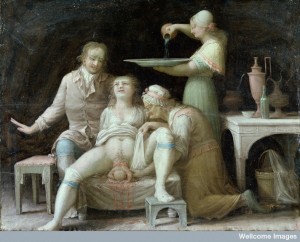
By Helen King
What do we look for in a midwife? Short nails feature a lot in the history of midwifery!
Many images of midwives from the past are very negative, like this one from around 1800. In a previous post, I looked at midwives as murderers. Let’s return to the good sort now. Back in the second century AD, a doctor called Soranus wrote a book we now know as the Gynaecology. In consecutive chapters, he first answers the question ‘Who is able to become a midwife?’ and then turns to ‘Who is the best midwife?’ Any midwife, he says, should ‘know her letters’ – which could perhaps be translated as ‘have a basic education’ – so that she can appreciate the theory of midwifery as well as its practical aspects. She should be discreet, knowledgeable, with a good memory; strong, and a hard worker, with long thin fingers and short nails. The ideal midwife should be trained in all three branches of medicine: diet, surgery and drugs. This is a very wide-ranging role, particularly in view of later debates about what interventions a midwife could legitimately carry out. She should also be free from superstition or greed.
Other than a few sections on the anatomy of the female external genitalia published in 1556, Soranus’ work was lost during the Renaissance, only reappearing in the nineteenth century, and even then not in its complete form. However, various adaptations of his work survived. So his image of the midwife continued to be transmitted. Here’s James Wolveridge, in his Speculum matricis of 1670:
The best midwife is she that is ingenuous, that knoweth letters, and having a good memory, is studious, neat and cleanly over the whole body, healthful, strong, and laborious, and well instructed in womens conditions, not too soon angry, not turbulent, or hasty, unsober, unchaste; but pleasant, quiet, prudent…
Although he gives us this ideal, his aim was to defend men’s right to intervene in childbirth.
The 1656 Compleat Midwife’s Practice contrasted this ideal with the ‘many unskilful women’ who ‘in these days … take upon them the knowledge of Midwifry, barely upon the priviledge of their age’.
At the end of the seventeenth century Robert Barret’s A companion for midwives, child-bearing women, and nurses directing them how to perform their respective offices also drew very clearly on Soranus in saying that the ideal midwife
… ought to be neither too young, nor too Old, of a good habit of Body, her Hands small and gentile, with her Nails pared close, and without Rings, in the time of her Duty. She must be chearful, pleasant, strong, laborious, and inur’d to Fatigue; it being required that she should be stirring at all hours, and abiding a long time together with her Patient.
She ought to be Courteous, Sober, Chaste; of an even patient Temper; not apt to repine or quarrel: she ought to be Wise and Silent, not apt to talk foolishly of what she sees in the Houses where she hath to do; to observe the Humour of her Patient, and endeavour to divert her with what she finds most agreeable. She ought to be a Woman of Understanding, capable to counsel, advise, and Comfort the Person in Labour; to bear her up under despondency, to fortify her against Fear, or Immoderate Repining. Lastly, she ought to be a Religious, Pious Woman.
So Soranus’ ideal midwife has a long history. Even in the eighteenth century, when men-midwives were insisting on the importance of knowledge of the pelvic anatomy, other features in their lists of the qualities of the best midwife recall Soranus; for example, William Smellie’s A Treatise on the Theory and Practice of Midwifery has her as ‘a decent, sensible woman of a middle age, able to bear fatigue’ who ‘ought to live in friendship with other women of the same profession, contending with them in nothing but in knowledge, sobriety, diligence, and patience’.
What strikes us today is that so much is about character, reputation and morality; midwifery has always been about rather more than ‘just’ training and experience!
